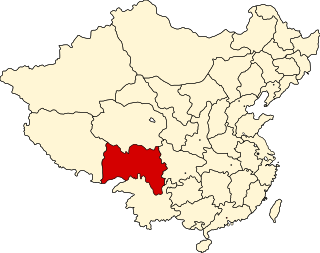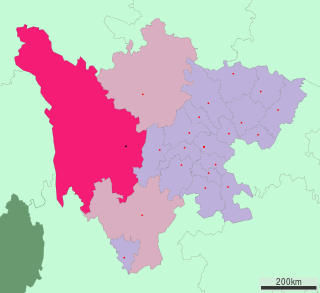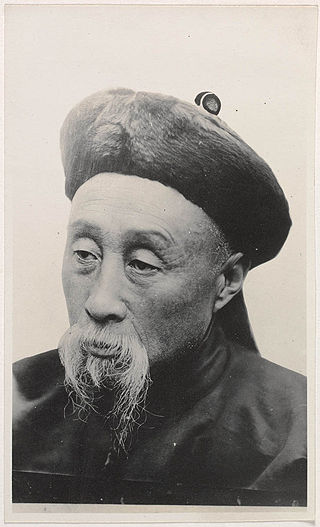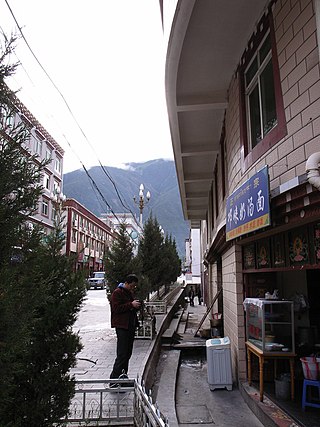Related Research Articles

Amdo is one of the three traditional Tibetan regions, the others being U-Tsang in the west and Kham in the east. Ngari in the north-west was incorporated into Ü-Tsang. Amdo is also the birthplace of the 14th Dalai Lama. Amdo encompasses a large area from the Machu to the Drichu (Yangtze). Amdo is mostly coterminous with China's present-day Qinghai province, but also includes small portions of Sichuan and Gansu provinces.

Kham is one of the three traditional Tibetan regions, the others being Amdo in the northeast, and Ü-Tsang in central Tibet. The original residents of Kham are called Khampas, and were governed locally by chieftains and monasteries. Kham presently covers a land area distributed between five regions in China, most of it in Tibet Autonomous Region and Sichuan, with smaller portions located within Qinghai, Gansu and Yunnan provinces.

Xikang was a nominal province formed by the Republic of China in 1939 on the initiative of prominent Sichuan warlord Liu Wenhui and retained by the early People's Republic of China. The former territory of Xikang is now divided between the Tibet Autonomous Region and Sichuan province.

Chushi Gangdruk was a Tibetan guerrilla group. Formally organized on 16 June 1958, the Chushi Gangdruk guerrilla fighters fought the forces of the People's Republic of China (PRC) in Tibet from 1956 to 1974.
Khams Tibetan is the Tibetic language used by the majority of the people in Kham. Khams is one of the three branches of the traditional classification of Tibetic languages. In terms of mutual intelligibility, Khams could communicate at a basic level with the Ü-Tsang branch.

Garzê Tibetan Autonomous Prefecture, often shortened to Ganzi Prefecture, is an autonomous prefecture in the western arm of Sichuan province, China bordering Yunnan to the south, the Tibet Autonomous Region to the west, and Gansu to the north and northwest.

Zhao Erfeng (1845–1911), courtesy name Jihe, was a late Qing Dynasty official and Han Chinese bannerman who belonged to the Plain Blue Banner. He was an assistant amban in Tibet at Chamdo in Kham. He was appointed in March, 1908 under Lien Yu, the main amban in Lhasa. Formerly Director-General of the Sichuan-Hubei Railway and acting viceroy of Sichuan province, Zhao was a much-maligned Chinese general of the late imperial era who led military campaigns throughout Kham, earning himself the nickname "the Butcher of Kham" and "Zhao the Butcher".

Batang Town, officially Xiaqiong Town, is a town in Batang County, Garzê Tibetan Autonomous Prefecture, Sichuan Province, in the China on the main route between Chengdu and Lhasa, Tibet, and just east of the Jinsha River, or Upper Yangtze River. It is at an elevation of 2,700 metres.

Batang County is a county located in western Garzê Tibetan Autonomous Prefecture, Sichuan Province, China. The main administrative centre is known as Batang Town.

Kathok Monastery, also transliterated as Kathog, Katok, or Katog, was founded in 1159 and is one of the "Six Mother Monasteries" in Tibet of the Nyingma school of Tibetan Buddhism, built after Samye Monastery. It is located in Payul, Garzê Prefecture, Sichuan, China, in the region traditionally known to Tibetans as Kham.

Gonchen Monastery, also known as Derge Monastery, is a large Sakya Tibetan Buddhist monastery in the town of Derge, in Sichuan, China. Gonchen is located in the ethnic Tibetan cultural region of Kham.

The Kingdom of Derge was a kingdom in Kham from the 15th to the 19th century. It was a center of industry, religion and politics, with the seat of its kingdom in the town of Degé. The kings of Derge belonged to a 1300-year lineage. During the Qing dynasty it was considered a Tusi under the umbrella of the Qing Empire.

Thokcha are tektites and meteorites which serve as amulets. Typically high in iron content, these are traditionally believed to contain a magical, protective power comparable to Tibetan dzi beads. Most thokcha are made of a copper alloy.
The Batang uprising was an uprising by the Khampas of Kham against the assertion of authority by Qing China.
Lingtsang was formerly one of the Kham region's five independent kingdoms of Tibet. The realm of Lingstang was incorporated into the People's Republic of China in 1950 following the Battle of Chamdo.

Tibet under Qing rule refers to the Qing dynasty's rule over Tibet from 1720 to 1912. The Qing rulers incorporated Tibet into the empire along with other Inner Asia territories, although the actual extent of the Qing dynasty's control over Tibet during this period has been the subject of political debate. The Qing called Tibet a fanbu, fanbang or fanshu, which has usually been translated as "vassal", "vassal state", or "borderlands", along with areas like Xinjiang and Mongolia. Like the preceding Yuan dynasty, the Manchus of the Qing dynasty exerted military and administrative control over Tibet, while granting it a degree of political autonomy.

Kingdom of Chakla or Chala was a kingdom in the Tibetan region of Kham.
The Hor States, also known as the Horpa States, were a group of five principalities located in the Tibetan region of Kham that existed from the 14th century to the mid-1900s.
Gonpo Namgyal (1799–1865), also known as Bulungwa, was a Tibetan rebel leader from the Nyarong who unified the region, then all of Kham in a series of campaigns from the 1840s to the 1860s, warring against the Qing Dynasty and the Ganden Phodrang. While he was initially successful in evading his powerful enemies, he was eventually captured and killed, putting an end to his state of Nyarong.
Chiefdom of Lithang, or Chiefdom of Litang, was an autonomous Tusi chiefdom that ruled Litang during the Qing dynasty period. Lithang, Bathang, Chakla and Derge were called the "Four Great Native Chiefdoms in Kham" (康区四大土司) by the Chinese.
References
- ↑ ""Nyarong County's Gonpo Namgyal" By Woeser". High Peaks, Pure Earth. October 12, 2011. Retrieved 29 May 2017.
- ↑ Yudru, Tsomu (April 2013). "Constructing Images of Gönpo Namgyel:a Hero or a Villain ?" (PDF). Revue d'études tibétaines (26): 57–91. Retrieved 2020-06-27.
- ↑ "Nyarong". Rigpa Wiki. 6 March 2016. Retrieved 29 May 2017.
- ↑ Powers, John; Templeman, David (18 May 2012). Historical Dictionary of Tibet. Scarecrow Press. p. 486. ISBN 9780810879843 . Retrieved 29 May 2017.
- ↑ Powers 2012, p. 487.
- ↑ Ronis 2011
- ↑ Yudru, Tsomu (2013). "Taming the Khampas: The Republican Construction of". Modern China. SAGE Publications. 39 (3): 319–344. doi:10.1177/0097700412464127. S2CID 145632928.
- ↑ Ronis, Jann (July 13, 2011). "An Overview of Nyarong". The Tibetan and Himalayan Library. Retrieved 29 May 2017.
- ↑ Powers 2012, p. 487.